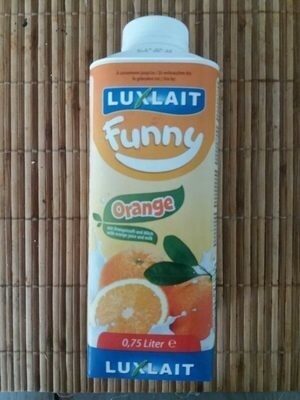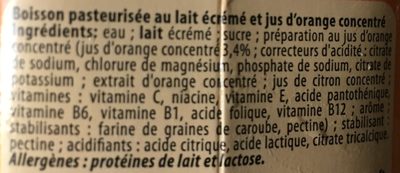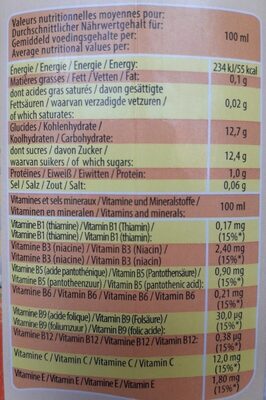Help us make food transparency the norm!
As a non-profit organization, we depend on your donations to continue informing consumers around the world about what they eat.
The food revolution starts with you!
Funny Orange 0.75L - Luxlait - 0,75 L
Funny Orange 0.75L - Luxlait - 0,75 L
This product page is not complete. You can help to complete it by editing it and adding more data from the photos we have, or by taking more photos using the app for Android or iPhone/iPad. Thank you!
×
Barcode: 5450168550506 (EAN / EAN-13)
Quantity: 0,75 L
Packaging: Tetra Pak, Bottle, Cardboard
Brands: Luxlait
Categories: Beverages, Dairies, Dairy drinks
Labels, certifications, awards:
FSC, FSC Mix, Green Dot, Fsc-c014047

Manufacturing or processing places: Luxembourg
Traceability code: LU L2 EC, FSC-C014047
Countries where sold: France, Luxembourg
Matching with your preferences
Health
Ingredients
-
30 ingredients
: Eau ; lait écrémé sucre ; préparation au jus d'orange concentré (jus d'orange concentré ; correcteurs d'acidité, citrate de sodium, chlorure de magnésium, phosphate de sodium, citrate de potassium ; extrait d'orange concentré ; jus de citron concentré vitamines : vitamine C, niacine, vitamine E, acide pantothénique, vitamine B6, vitamine B1, acide folique, vitamine B12 ; arôme : farine de graines de caroube, pectine) ; stabilisant stabilisants : Pectine ; acidifiants : acide citrique ,acide lactique, citrate tricalcique.Allergens: Milk
Food processing
-
Ultra processed foods
Elements that indicate the product is in the 4 - Ultra processed food and drink products group:
- Additive: E440 - Pectins
- Ingredient: Flavouring
Food products are classified into 4 groups according to their degree of processing:
- Unprocessed or minimally processed foods
- Processed culinary ingredients
- Processed foods
- Ultra processed foods
The determination of the group is based on the category of the product and on the ingredients it contains.
Additives
-
E270 - Lactic acid
Lactic acid: Lactic acid is an organic compound with the formula CH3CH-OH-COOH. In its solid state, it is white and water-soluble. In its liquid state, it is colorless. It is produced both naturally and synthetically. With a hydroxyl group adjacent to the carboxyl group, lactic acid is classified as an alpha-hydroxy acid -AHA-. In the form of its conjugate base called lactate, it plays a role in several biochemical processes. In solution, it can ionize a proton from the carboxyl group, producing the lactate ion CH3CH-OH-CO−2. Compared to acetic acid, its pKa is 1 unit less, meaning lactic acid deprotonates ten times more easily than acetic acid does. This higher acidity is the consequence of the intramolecular hydrogen bonding between the α-hydroxyl and the carboxylate group. Lactic acid is chiral, consisting of two optical isomers. One is known as L--+--lactic acid or -S--lactic acid and the other, its mirror image, is D--−--lactic acid or -R--lactic acid. A mixture of the two in equal amounts is called DL-lactic acid, or racemic lactic acid. Lactic acid is hygroscopic. DL-lactic acid is miscible with water and with ethanol above its melting point which is around 17 or 18 °C. D-lactic acid and L-lactic acid have a higher melting point. In animals, L-lactate is constantly produced from pyruvate via the enzyme lactate dehydrogenase -LDH- in a process of fermentation during normal metabolism and exercise. It does not increase in concentration until the rate of lactate production exceeds the rate of lactate removal, which is governed by a number of factors, including monocarboxylate transporters, concentration and isoform of LDH, and oxidative capacity of tissues. The concentration of blood lactate is usually 1–2 mM at rest, but can rise to over 20 mM during intense exertion and as high as 25 mM afterward. In addition to other biological roles, L-lactic acid is the primary endogenous agonist of hydroxycarboxylic acid receptor 1 -HCA1-, which is a Gi/o-coupled G protein-coupled receptor -GPCR-.In industry, lactic acid fermentation is performed by lactic acid bacteria, which convert simple carbohydrates such as glucose, sucrose, or galactose to lactic acid. These bacteria can also grow in the mouth; the acid they produce is responsible for the tooth decay known as caries. In medicine, lactate is one of the main components of lactated Ringer's solution and Hartmann's solution. These intravenous fluids consist of sodium and potassium cations along with lactate and chloride anions in solution with distilled water, generally in concentrations isotonic with human blood. It is most commonly used for fluid resuscitation after blood loss due to trauma, surgery, or burns.Source: Wikipedia
-
E330 - Citric acid
Citric acid is a natural organic acid found in citrus fruits such as lemons, oranges, and limes.
It is widely used in the food industry as a flavor enhancer, acidulant, and preservative due to its tart and refreshing taste.
Citric acid is safe for consumption when used in moderation and is considered a generally recognized as safe (GRAS) food additive by regulatory agencies worldwide.
-
E331 - Sodium citrates
Sodium citrate: Sodium citrate may refer to any of the sodium salts of citrate -though most commonly the third-: Monosodium citrate Disodium citrate Trisodium citrateThe three forms of the salt are collectively known by the E number E331. Sodium citrates are used as acidity regulators in food and drinks, and also as emulsifiers for oils. They enable cheeses to melt without becoming greasy.Source: Wikipedia
-
E332 - Potassium citrates
Potassium citrate: Potassium citrate -also known as tripotassium citrate- is a potassium salt of citric acid with the molecular formula K3C6H5O7. It is a white, hygroscopic crystalline powder. It is odorless with a saline taste. It contains 38.28% potassium by mass. In the monohydrate form it is highly hygroscopic and deliquescent. As a food additive, potassium citrate is used to regulate acidity and is known as E number E332. Medicinally, it may be used to control kidney stones derived from either uric acid or cystine.Source: Wikipedia
-
E339 - Sodium phosphates
Sodium phosphates: Sodium phosphate is a generic term for a variety of salts of sodium -Na+- and phosphate -PO43−-. Phosphate also forms families or condensed anions including di-, tri-, tetra-, and polyphosphates. Most of these salts are known in both anhydrous -water-free- and hydrated forms. The hydrates are more common than the anhydrous forms.Source: Wikipedia
-
E440 - Pectins
Pectins (E440) are natural carbohydrates, predominantly found in fruits, that act as gelling agents in the food industry, creating the desirable jelly-like texture in jams, jellies, and marmalades.
Pectins stabilize and thicken various food products, such as desserts, confectioneries, and beverages, ensuring a uniform consistency and quality.
Recognized as safe by various health authorities, pectins have been widely used without notable adverse effects when consumed in typical dietary amounts.
-
E511 - Magnesium chloride
Magnesium chloride: Magnesium chloride is the name for the chemical compound with the formula MgCl2 and its various hydrates MgCl2-H2O-x. These salts are typical ionic halides, being highly soluble in water. The hydrated magnesium chloride can be extracted from brine or sea water. In North America, magnesium chloride is produced primarily from Great Salt Lake brine. It is extracted in a similar process from the Dead Sea in the Jordan Valley. Magnesium chloride, as the natural mineral bischofite, is also extracted -by solution mining- out of ancient seabeds, for example, the Zechstein seabed in northwest Europe. Some magnesium chloride is made from solar evaporation of seawater. Anhydrous magnesium chloride is the principal precursor to magnesium metal, which is produced on a large scale. Hydrated magnesium chloride is the form most readily available.Source: Wikipedia
Ingredients analysis
-
Palm oil content unknown
Unrecognized ingredients: fr:preparation-au-jus-d-orange-concentre, fr:jus-de-citron-concentre-vitamines, fr:stabilisant-stabilisantsSome ingredients could not be recognized.
We need your help!
You can help us recognize more ingredients and better analyze the list of ingredients for this product and others:
- Edit this product page to correct spelling mistakes in the ingredients list, and/or to remove ingredients in other languages and sentences that are not related to the ingredients.
- Add new entries, synonyms or translations to our multilingual lists of ingredients, ingredient processing methods, and labels.
If you would like to help, join the #ingredients channel on our Slack discussion space and/or learn about ingredients analysis on our wiki. Thank you!
-
Non-vegan
Non-vegan ingredients: Skimmed milkSome ingredients could not be recognized.
We need your help!
You can help us recognize more ingredients and better analyze the list of ingredients for this product and others:
- Edit this product page to correct spelling mistakes in the ingredients list, and/or to remove ingredients in other languages and sentences that are not related to the ingredients.
- Add new entries, synonyms or translations to our multilingual lists of ingredients, ingredient processing methods, and labels.
If you would like to help, join the #ingredients channel on our Slack discussion space and/or learn about ingredients analysis on our wiki. Thank you!
-
Vegetarian status unknown
Unrecognized ingredients: fr:preparation-au-jus-d-orange-concentre, Sodium citrate, fr:jus-de-citron-concentre-vitamines, Vitamin E, Thiamin, Folic acid, Vitamin b12, fr:stabilisant-stabilisantsSome ingredients could not be recognized.
We need your help!
You can help us recognize more ingredients and better analyze the list of ingredients for this product and others:
- Edit this product page to correct spelling mistakes in the ingredients list, and/or to remove ingredients in other languages and sentences that are not related to the ingredients.
- Add new entries, synonyms or translations to our multilingual lists of ingredients, ingredient processing methods, and labels.
If you would like to help, join the #ingredients channel on our Slack discussion space and/or learn about ingredients analysis on our wiki. Thank you!
-
Details of the analysis of the ingredients
We need your help!
Some ingredients could not be recognized.
We need your help!
You can help us recognize more ingredients and better analyze the list of ingredients for this product and others:
- Edit this product page to correct spelling mistakes in the ingredients list, and/or to remove ingredients in other languages and sentences that are not related to the ingredients.
- Add new entries, synonyms or translations to our multilingual lists of ingredients, ingredient processing methods, and labels.
If you would like to help, join the #ingredients channel on our Slack discussion space and/or learn about ingredients analysis on our wiki. Thank you!
: Eau, _lait_ écrémé, préparation au jus d'orange concentré (jus d'orange concentré, correcteurs d'acidité, citrate de sodium, chlorure de magnésium, phosphate de sodium, citrate de potassium, orange, jus de citron concentré vitamines, vitamine C, niacine, vitamines, vitamine E, acide pantothénique, vitamine B6, vitamines, vitamine B1, acide folique, vitamine B12, arôme (farine de graines de caroube), pectine), stabilisant stabilisants (Pectine), acidifiants (acide citrique), acide lactique, citrate tricalcique- Eau -> en:water - vegan: yes - vegetarian: yes - ciqual_food_code: 18066 - percent_min: 14.2857142857143 - percent_max: 100
- _lait_ écrémé -> en:skimmed-milk - vegan: no - vegetarian: yes - ciqual_proxy_food_code: 19051 - percent_min: 0 - percent_max: 50
- préparation au jus d'orange concentré -> fr:preparation-au-jus-d-orange-concentre - percent_min: 0 - percent_max: 33.3333333333333
- jus d'orange concentré -> en:concentrated-orange-juice - vegan: yes - vegetarian: yes - ciqual_proxy_food_code: 2070 - percent_min: 0 - percent_max: 33.3333333333333
- correcteurs d'acidité -> en:acidity-regulator - percent_min: 0 - percent_max: 16.6666666666667
- citrate de sodium -> en:sodium-citrate - percent_min: 0 - percent_max: 11.1111111111111
- chlorure de magnésium -> en:e511 - vegan: yes - vegetarian: yes - percent_min: 0 - percent_max: 8.33333333333333
- phosphate de sodium -> en:e339 - vegan: yes - vegetarian: yes - percent_min: 0 - percent_max: 6.66666666666667
- citrate de potassium -> en:e332ii - vegan: yes - vegetarian: yes - percent_min: 0 - percent_max: 5.55555555555556
- orange -> en:orange - vegan: yes - vegetarian: yes - ciqual_proxy_food_code: 13034 - percent_min: 0 - percent_max: 4.76190476190476
- jus de citron concentré vitamines -> fr:jus-de-citron-concentre-vitamines - percent_min: 0 - percent_max: 4.16666666666667
- vitamine C -> en:e300 - vegan: yes - vegetarian: yes - percent_min: 0 - percent_max: 3.7037037037037
- niacine -> en:e375 - vegan: maybe - vegetarian: maybe - percent_min: 0 - percent_max: 3.33333333333333
- vitamines -> en:vitamins - vegan: yes - vegetarian: yes - percent_min: 0 - percent_max: 3.03030303030303
- vitamine E -> en:vitamin-e - percent_min: 0 - percent_max: 2.77777777777778
- acide pantothénique -> en:pantothenic-acid - vegan: yes - vegetarian: yes - percent_min: 0 - percent_max: 2.56410256410256
- vitamine B6 -> en:vitamin-b6 - vegan: yes - vegetarian: yes - percent_min: 0 - percent_max: 2.38095238095238
- vitamines -> en:vitamins - vegan: yes - vegetarian: yes - percent_min: 0 - percent_max: 2.22222222222222
- vitamine B1 -> en:thiamin - percent_min: 0 - percent_max: 2.08333333333333
- acide folique -> en:folic-acid - percent_min: 0 - percent_max: 1.96078431372549
- vitamine B12 -> en:vitamin-b12 - percent_min: 0 - percent_max: 1.85185185185185
- arôme -> en:flavouring - vegan: maybe - vegetarian: maybe - percent_min: 0 - percent_max: 1.75438596491228
- farine de graines de caroube -> en:carob-seed-flour - vegan: yes - vegetarian: yes - ciqual_proxy_food_code: 9410 - percent_min: 0 - percent_max: 1.75438596491228
- pectine -> en:e440a - vegan: yes - vegetarian: yes - percent_min: 0 - percent_max: 1.66666666666667
- stabilisant stabilisants -> fr:stabilisant-stabilisants - percent_min: 0 - percent_max: 25
- Pectine -> en:e440a - vegan: yes - vegetarian: yes - percent_min: 0 - percent_max: 25
- acidifiants -> en:acid - percent_min: 0 - percent_max: 20
- acide citrique -> en:e330 - vegan: yes - vegetarian: yes - percent_min: 0 - percent_max: 20
- acide lactique -> en:e270 - vegan: yes - vegetarian: yes - percent_min: 0 - percent_max: 16.6666666666667
- citrate tricalcique -> en:e333 - vegan: yes - vegetarian: yes - percent_min: 0 - percent_max: 14.2857142857143
Nutrition
-
Bad nutritional quality
⚠ ️Warning: the amount of fiber is not specified, their possible positive contribution to the grade could not be taken into account.⚠ ️Warning: the amount of fruits, vegetables and nuts is not specified on the label, it was estimated from the list of ingredients: 5This product is considered a beverage for the calculation of the Nutri-Score.
Positive points: 0
- Proteins: 0 / 5 (value: 1, rounded value: 1)
- Fiber: 0 / 5 (value: 0, rounded value: 0)
- Fruits, vegetables, nuts, and colza/walnut/olive oils: 0 / 10 (value: 5.44084821428572, rounded value: 5.4)
Negative points: 16
- Energy: 8 / 10 (value: 218, rounded value: 218)
- Sugars: 8 / 10 (value: 11.8, rounded value: 11.8)
- Saturated fat: 0 / 10 (value: 0, rounded value: 0)
- Sodium: 0 / 10 (value: 40, rounded value: 40)
The points for proteins are not counted because the negative points are greater or equal to 11.
Nutritional score: (16 - 0)
Nutri-Score:
-
Nutrient levels
-
Fat in low quantity (0.1%)
What you need to know- A high consumption of fat, especially saturated fats, can raise cholesterol, which increases the risk of heart diseases.
Recommendation: Limit the consumption of fat and saturated fat- Choose products with lower fat and saturated fat content.
-
Saturated fat in low quantity (0%)
What you need to know- A high consumption of fat, especially saturated fats, can raise cholesterol, which increases the risk of heart diseases.
Recommendation: Limit the consumption of fat and saturated fat- Choose products with lower fat and saturated fat content.
-
Sugars in high quantity (11.8%)
What you need to know- A high consumption of sugar can cause weight gain and tooth decay. It also augments the risk of type 2 diabetes and cardio-vascular diseases.
Recommendation: Limit the consumption of sugar and sugary drinks- Sugary drinks (such as sodas, fruit beverages, and fruit juices and nectars) should be limited as much as possible (no more than 1 glass a day).
- Choose products with lower sugar content and reduce the consumption of products with added sugars.
-
Salt in low quantity (0.1%)
What you need to know- A high consumption of salt (or sodium) can cause raised blood pressure, which can increase the risk of heart disease and stroke.
- Many people who have high blood pressure do not know it, as there are often no symptoms.
- Most people consume too much salt (on average 9 to 12 grams per day), around twice the recommended maximum level of intake.
Recommendation: Limit the consumption of salt and salted food- Reduce the quantity of salt used when cooking, and don't salt again at the table.
- Limit the consumption of salty snacks and choose products with lower salt content.
-
-
Nutrition facts
Nutrition facts As sold
for 100 g / 100 mlAs sold
per serving (25 cl)Compared to: Dairy drinks Energy 218 kj
(52 kcal)545 kj
(130 kcal)-21% Fat 0.1 g 0.25 g -94% Saturated fat 0 g 0 g -100% Carbohydrates 11.8 g 29.5 g +28% Sugars 11.8 g 29.5 g +38% Fiber ? ? Proteins 1 g 2.5 g -68% Salt 0.1 g 0.25 g -19% Fruits‚ vegetables‚ nuts and rapeseed‚ walnut and olive oils (estimate from ingredients list analysis) 5.441 % 5.441 %
Environment
-
Eco-Score not computed - Unknown environmental impact
We could not compute the Eco-Score of this product as it is missing some data, could you help complete it?Could you add a precise product category so that we can compute the Eco-Score? Add a category
Packaging
-
Packaging with a medium impact
-
Packaging parts
Bottle (Cardboard)
Brick (Tetra Pak)
-
Packaging materials
Material % Packaging weight Packaging weight per 100 g of product Paper or cardboard
-
Transportation
-
Origins of ingredients
Missing origins of ingredients information
⚠ ️ The origins of the ingredients of this product are not indicated.
If they are indicated on the packaging, you can modify the product sheet and add them.
If you are the manufacturer of this product, you can send us the information with our free platform for producers.Add the origins of ingredients for this product Add the origins of ingredients for this product
Report a problem
-
Incomplete or incorrect information?
Category, labels, ingredients, allergens, nutritional information, photos etc.
If the information does not match the information on the packaging, please complete or correct it. Open Food Facts is a collaborative database, and every contribution is useful for all.
Data sources
Product added on by openfoodfacts-contributors
Last edit of product page on by packbot.
Product page also edited by beniben, kiliweb, roboto-app, yuka.JIl_Z8CSFJ0AJPPj3p0d2B2WKdbJG9l5PHwNoQ, yuka.WDU1Wk5xUUdpUFlucHZJMDlBN2IvUE5mK2FDQVVENlFOK2cxSVE9PQ, yuka.sY2b0xO6T85zoF3NwEKvlkwXY_3HqWL5NkHuxmC7xYafEL3ofNJtxYHYa6o.










